Many obstacles overcome, still more to go.
About a month ago I posted a list of stuck-points on the project – fortunately since then, with a lot of effort and tool purchases, progress has been made! Have put more time into the car this past month, than in any month so far. First, an update on each of the old sticking points-
Power steering leakage
New pump was purchased and super-carefully installed. All lines cinched up, and no leaks after a couple weeks, yay! Still have to see how it holds up under the pressure of real use with the pump cranking away, but so far so good.
Brake line fitting leakage
This was due to an incorrect flex line in the rear – correct part ordered and installed, and the brakes were bled, no leaks! My brake bleeding assistant, who’s never driven a manual car, had some trouble with my instructions to “push the pedal in the middle” – since the throttle pedal was sunken to the floor, the clutch appeared in the middle of the e-brake, clutch, and brake pedals. I’m going from corner to corner, wondering why fluid is barely eking out as I hear her pumping away! 🙂 A little revised instruction and it’s good to go.
Still had some air after a couple passes, at which point I realized the multi-piston Wilwoods need to be bled at the top of both caliper halves (inner and outer) to get all the air out. Last few bubbles gone and the brake pedal feels very firm inside.
Leaf Springs
This was a rather labor intensive process. In typical easier-said-than-done fashion they were cut down 2.25″ in length; bushings were trimmed or hogged out to fit appropriate sleeves for mount bolts; the front spring eyes were flipped and ground for clearance; initially the rears were flipped also but it looked like clearance would be an even bigger problem, so they were left upright, but still got some grinding.
This has an ultra-scientific “one to two finger gap” in the rear. Added about 65 lbs. of fuel (more on that later) which only brought it down about 1/8″. Only weight left to go in is the headliner and door glass, so this is where it’ll be for now. It’s not likely this spring rate will be the one I wish to keep forever, so for the next pair of springs, it should be easy enough to request an additional ride height decrease, in addition to the spring length decrease. Bushing work will swap over.
Oh, and in the picture above, the rear wheel has 3/4″ of spacer. There’s room to go inboard or outboard bit if needed, but this provided a more athletic appearing stance, while still providing for tons of wheelwell clearance in all directions. At this setting rear track width is 70.75″, which still, isn’t *that* wide. It’s about 4″ wider than my 240sx was, and about 7″ narrower than the Viper.
Road Draft Tube
Have to thank my buddy John Coffey for talking me through this one. Tried several different things and took a long time with this, and ultimately found a solution. This item was holding up permanent installation for a lot of simple things in the engine bay, so once it was out of the way a lots fell quickly into place – carburetor, fuel lines, distributor, throttle and choke linkages, etc. The tube coming off the road draft vent hole is the black one fuzzily visible in the passenger side carb photo below-
You may note, the stock-style valve covers. These are actually the third set of valve covers I have for this thing – the first set didn’t fit the bolt pattern (they’re for an even older small block) and the second set were a bit bigger and made of thicker material. They *look* nice and original, but caused all kinds of interference problems with things like the fuel line and the bracket for the power brake booster vacuum line, visible above. While in general I’m not a fan of extra chrome, these are at least very lightweight, and totally stock.
Coolant Temp Sensor Port
This problem begat a bevy of tool purchases. After nothing could convince the old plug to come out, began drilling with ever-larger holes. The largest thing I had on hand for going through metal was 3/8″ (bits and chucks), so it was time for some upgraded hardware. Now have a new 1/2″ chuck drill, and an array of drill bits up to 1″ in size.
Also bought a 1/2″ NPT tap to repair the threads, and a special 45/64″ bit as the final pass before using the tap. After using the 45/64″ bit, all that was left of the plug was like foil and I could pull it out with needle-nose pliers.
Hooray! Coolant temp sensor in its appropriate location!
Also visible in this pic, is the new oil pressure sensor. This is a 1/8″ NPT sensor occupying a small port in the block previously filled with a small square plug. This too necessitated some tool purchases since it was a 7mm square plug, so none of my 6-point sockets would fit it, and the only way to fit a wrench on it, would be to pull off the water pump; no thanks. Ended up buying one of these universal socket things, advertised to work on 1/4″ – 3/4″ bolt heads of all shapes and sizes. After some monkeying, it got a grip on the thing and got it out. The tool earned its keep in that one action!
Perhaps apparent from the way the wires for the oil pressure sensor have been run, am making a big effort to keep the wiring tidy and professional in the car. Bought a ton of heat shrink tubing and overlay sheathing, in an attempt to keep everything clean, bundled, and protected.
Vent Windows
No progress on here from last time. The passenger vent window is just about ready to go in, been focused on what’s needed to get it running.
New Progress
Lots of other progress has been made in addition to getting the above accomplished.
First Fuel Purchase
One of the simpler ones – the fuel line installation was completed, so it made sense to get some gas. We happen to have a very neat retro gas station just a few miles from the house, that sells all sorts of good gas right at the pump, and comes complete with a smiling young man offering to clean your windows or check your oil. It’s mostly frequented by the well-to-do’ers of RSF, topping off their Range Rovers and exotic sports cars. I felt out of place with two crummy 5 gallon plastic jugs in the pickup, but the Camaro will look right at home there.
Oh, and this is the only station I’ve bought gas in, in the last 10 years, where you don’t have to pre-pay. Got a lucky click-off of the pump, no coins! Hopefully a sign of good ProSolo reaction times to come. 🙂
Windshield Wipers
This is another that seems like a no-brainer…which of course wasn’t.
Had the body shop install the wiper motor and attach to the wiper arms at the body shop, as doing so requires having the cowl panel off, and installation or removal of a body panel, is a big opportunity to scratch up the paint on said panel.
Unfortunately the wiper arms were not “clocked” to the motor correctly, causing the wiper blade to want to swing down initially, instead of up. So off came the cowl panel, some time spent futzing with the mechanism orientation, but ultimately, the wipers made it in, and I managed to get the cowl back on without messing anything up too badly.
The car had no wipers when I got it, now it has working ones, ha!
Pedals and Header-back Exhaust
The car has four functional pedals at last! Well, the gas pedal may not make it go yet, but it does open the throttle, now that the road draft tube shenanigans were handled.
Brakes were made ok with the bleeding a little while back, and the clutch was okay, as the pressure plate provides most of the springing, but the complementary clutch return spring that keeps the pedal up against the stop, has also been installed.
The parking brake pedal was the last to be made functional. The Wilwood rear disc brake setup on the car has a complete functional parking brake, but comes without a means of adapting it to the factory cable system. Fortunately the solution was pretty simple, with a pair of Lokar “Explorer style” clevises, drilled out to accept the factory parking brake cable. The entire parking brake system is not entirely new, from the rubber of the pedal pad, to the drum lining at each rear wheel.
As you can tell from the second picture, at this point, the exhaust ends at the mufflers. When I get the car to an exhaust shop, will have to see what can be done to extend the exit either to the traditional location, or out the sides. The panhard rod in the rear suspension complicates things.
Ride Heights
They still aren’t right. Rear is too high, as discussed above. I’ve raised the front “2 turns” (haven’t done the math to figure how that equates to inches), but it probably needs to come up more.
This picture was taken a few days ago, before fuel and coolant were added, so both front and rear have since come down a little bit.
You’d think moving the car around a garage floor on dollies like this would be easy – nope, big effort required!
Before trying to drive it anywhere, I’ll probably raise the front another 2 turns.
The Vintage mags with 27+” tall tires will fill the wheelwells better than the Jongbloeds and AD08 rubber. The shorter /35 series front tire vs. the /40 series on the rear, exaggerates the ride height difference.
No problem turning to full lock, even at this ride height-
Pic inside of the front suspension with the wheel turned- contact point at extreme bump, is the lower control arm to the factory bump stop bracket, welded on the frame. At this ride height, it has about 1.25-1.5″ of travel there, equating to about 2″ of travel out at the tire.
Oh, and a funny one-
The family car had to go in for service (Infiniti is paranoid after the Toyota/Lexus unintended acceleration debacle, and is issuing recalls on the new JX35 like crazy. The car needed 5 recalls done, which necessitated an overnight stay) – and since they were busy and out of branded loaners, we got a crummy rental – the Chevy Sonic. The Sonic is one of these economical small cars – not micro like the Smart or Scion IQ, but subcompact like the Toyota Yaris, Mazda 2, or Honda Fit. When my Tundra was serviced I got a Yaris SE loaner, which was actually decent, but this Sonic LT was crap! Anyway, it got to park next to the Camaro one night.
What amazed me was how TALL the Sonic is! Check out this picture-
It only looks a few inches taller than the Camaro…until we see the Camaro is sitting on 5″ tall dollies! Will have to measure the Camaro once it’s back on the ground, but I’m pretty sure its roofline is around 48″, the Sonic (and lots of other cars like it) have rooflines about 60″. Wow.
Battery
Ok, so I put it in the trunk, not very exciting. This is an Odyessy PC680, common in the aftermarket. It’s 13-14lbs., vs the 35+ of the stock battery, hanging way out past the nose. Here’s it’s mounted fairly high, but more or less at the rear axle centerline.
Have more thoughts on general battery placement, will have to share another time.
This battery was bought to get the car going (figuratively, not literally) – since in the beginning it is likely to get cranked a lot without much chance to charge normally, and this should stand up ok to that use. The *real* battery I plan on using is the C680 XS Power battery, which is only about 4 lbs., and is the same form factor as the PC680, meaning it will fit in that mount.
Interior
The insides of the car received some attention, mostly in the instrumentation area.
Steering was a bit out of whack, had to purchase a puller to get it all apart and re-clocked correctly, but it could at least be buttoned up-
The wrap will come off soon! Still getting my hands dirty doing stuff, just not as bad as before.
Note the cover plate over the center of the dash – bare as a no-option car can be.
Couple other things to see – the switch at bottom left, and of course the DASH2 dash. The switch will be an independent control of power for the DL1 and DASH2. The idea is, I can keep it on, to help let the DL1 keep GPS lock between runs, or any other time I want to have the engine off but instrumentation on. Modern cars tend to have as their key positions, Off -> Accessory -> Ignition -> Run. This car has Off -> Accessory + Ignition -> Run. Want to be able to keep some of the electronics going, without all of it going.
Speaking of the DL1, it got its own custom bracket, just below the dash, to the right of the steering column.
That silly bracket took a ton of time to measure and bend up, and I’m still not totally happy with how it ended up, as I had to change its position slightly to avoid having to use a serial extender between the DASH2 and the DL1.
With this configuration, the DL1 will be recording information from sensors (like coolant temp, RPM, and oil pressure) in addition to the things it can figure out on its own – speed and accelerations – and present this data to the DASH2, as configured, over an RS232 serial connection. This is handy, because you can’t really look at gauges while autocrossing. You might have a chance to look at the tach when doing an initial 1-2 shift, but that’s about it really. On the track you can take a glance for a second or so while on a straightaway, to ensure systems are still healthy, possibly even changing your approach if you see oil temps climbing, or something like that. In autocross you go out and hope the car makes it through the run without self-destructing. If you are having momentary drops of oil pressure, there’s no way you’ll see it, without some kind of alarm light programmed in, but that can be tricky, since 20psi might be OK at idle but death at 6k RPM. With the data acquisition, you’re watching the gauges 100 times per second, and if there are any concerning fluctuations, they can be correlated to other events, like hard right-handers following a braking zone, for instance.
In this photo it isn’t yet talking to the DL1, so it only knows to output fuel level, which it will get from the main vehicle harness, and will not be datalogged. Common Camaro Lore dictates one most always autocross a first or second gen Camaro with a completely full gas tank. I’m hoping that’s not actually the case, will find out soon enough.
The DASH2 is mounted to the steering column via a custom bracket I made. When I envisioned the bracket, it had to be carbon fiber, and making it so, took extra time. In trying to get a photo of it tonight, I now realize now silly that probably was, you can only really see it when looking down through the windshield. Here it is, from roughly the middle of the car up against the windshield, looking back and left-
Even if the aesthetics aren’t perfect, pretty happy with how it turned out functionally. The size and positioning of the bracket and DASH2 unit, allow the wheel its full range of tilt adjustment, without bind or interference. Here it is fully tilted up-
With the steering wheel in a normal position, eye level is slightly above the unit, which is supposed to be optimal for its viewing.
Race-Technology was very supportive in sending me out a loaner so I could get the car fired up, while they send my bricked unit back to the UK for repairs. Thanks Al Seim and R-T USA!
Belts
Not very exciting, was able to get a good length PS belt on the second try, looks like I’ll need a third attempt to get an alternator/fan belt of the right length, this one is a bit too long-
Looks like I may need to spend some time shimming the PS and water pump pulleys to get perfect alignment. Like so many things, you think belts will be a 5 minute deal, and it turns into hours… 🙂
###
The plan for the moment is to get it running, and solid enough to not fall apart or puke its fluids out everywhere on a short drive. Want to make sure it builds oil pressure by free-cranking it with the plugs out, before they go in and I try to fire it. It *should* be fine as it ran great on the engine dyno, but that was over 2 years ago, and it has since received a new oil pan.
It’ll need to go to an interior shop to get the headliner put in (it’s a least a 2-person, if not 3-person job on these cars), then to an exhaust shop (have some tweaks to the Magnaflow system I need/want), and to ProParts USA for some shocks. I want to have the car ready for the San Diego National Tour, which is a short three months away!
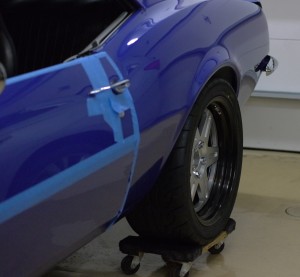
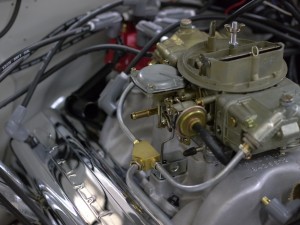
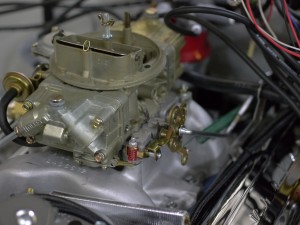
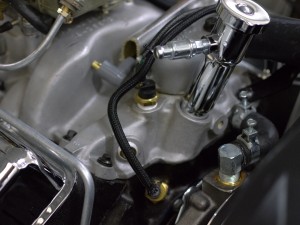
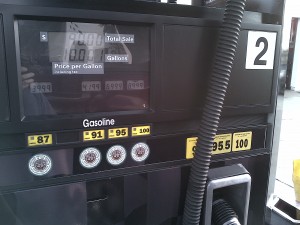
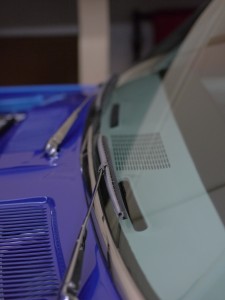
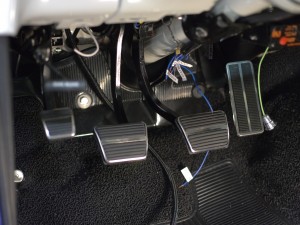
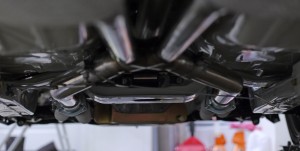
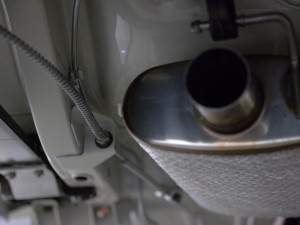
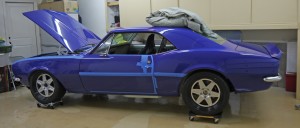
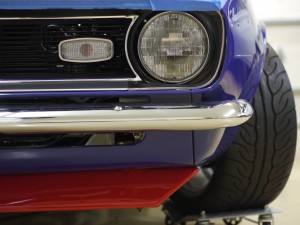
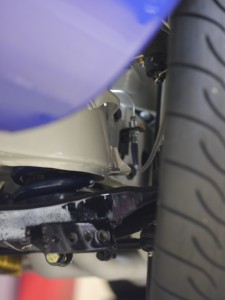
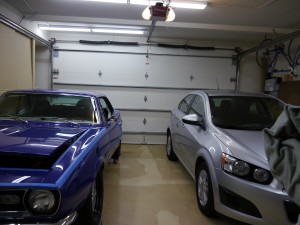
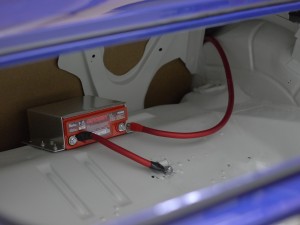

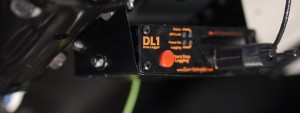
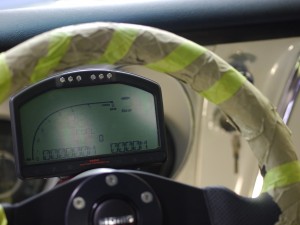
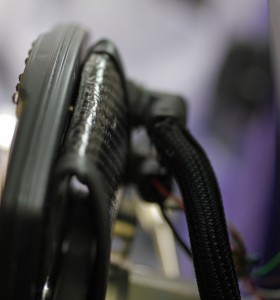
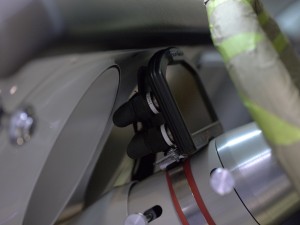
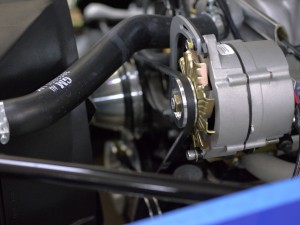
Good progress, cant wait to see what the final weight comes in at. Couple of general questions/ comments:
What is the final tire size / wheel size / backspacing / front camber in the pictures above?
Do the rules allow a simple lowering block on the rear springs?
You have a picture of the front suspension, with a dimension from the lower control arm to the frame bump stop bracket. Is the distance you mentioned, 1.25-1.5 inches, measured without any rubber bumpstop installed? And are you going to run without a compressible bumpstop? And is 2″ of tire travel doable in autocrossing these days?
I have owned many Camaros, but never an original z28. Is the water line from the manifold to the waterpump correct? Is it restricted? It would seem like a huge radiator bypass. Is it used only in heater delete applications?
Likewise, I have never seen the oil pressure sender on the front of the block, usually mounted in the rear. Is that a z28 only thing?
I love the chevrolet script valve covers, but the red front spoiler looks a little odd.
Lastly, are those small batteries streetable? Or are they a maintenance headache?
Hi Louis,
Great questions as always!
Tire size in those pictures is 265/35-18 front, 265/40-18 rear. Tires are Yokohama Advan Neova AD08. There are some new ST tires slated for release in early 2013, so those aren’t necessarily the ones I’ll be sticking with long term, though I do like those sizes a lot for this car.
I do not plan on running a bump stop, at least initially. If I decide to add one later, it’ll probably be on the shock, instead of the factory location on the chassis. In general I am not a fan of bumpstops and for most people in racing situations, feel they do more harm than good. 2″ of tire travel should be enough – I am running this car much much stiffer than most people with these cars run. Despite a high (well into 4 digits) spring rate, the “wheel rate” really isn’t that high, in fact it’s a little lower than where I ended up with the 240sx I ran in the Street Touring category years ago. Spring rates will change over time, but in general I think 2″ of bump travel is ok – it can still droop 2″ or more, allowing for 4″ of total travel.
Yes, that bypass fitting out of the waterpump is correct. There is some debate about the shape of the fitting out of the waterpump (square vs. hex) but it is something all Z28s had, not just those with heater delete.
If the car had an oil pressure gauge from the factory, it would have been at the rear port near the distributor. The port on the front works too, and is maybe easier to tell if it’s leaking. It’s also where the Penske team ran their sensor. In my case, the aftermarket electronic pressure sensor had a large-ish body that necessitated its installation up front.
The spoiler is another Penske thing. When they ran two cars, one got a yellow front spoiler (which more directly complemented the blue/yellow Sunoco graphics), and the other got a red. Maybe it was so the spotters could tell the cars apart from a distance? In any case, having seen the original ’67 and ’68 Penske Z28s in action at the Monterey Historics, the look that really “pops” for me is the ’67 with its vent windows, updated with ’68 fascia bits, running the red spoiler.
The small batteries can be streetable – they’re not too bad if used often (as long as the electrical demands aren’t too crazy) -the challenge is keeping them happy when sitting for a long time. A tender is a good thing to have.
You are staying with the 18×9 with 5.5bs on front with no spacer correct? Would love to see a picture of how much space you have from the wheel to the tie rod/steering arm.
Does your front require a limiting device to keep the spring from falling out when jacked up?
It certainly wins for best exhaust note of anything in your class!!
Ahh yes – wheels.
In front I currently have 1″ of spacer, so an effective 4.5″ backspace. In the rear the wheels are 5″ backspace with 3/4″ spacer, for an effective 4.25″ backspace.
The front is 18’s, and there’s plenty of space to the steering arm, since it has the Z28 steering arms, and not any sort of bump steer spacers. I’ll see if I can get a pic for you, still need to get in there and make sure all the grease fittings and cotter pins are set. There are something like 10 of each just for the front suspension!
How much spacer I run in front ultimately depends a bit on camber. If I stick with the current setting of about -5.5, then I can run the 1″ spacer. If I go down in camber to something like -4 degrees, may have to take out a little spacer and bring it more inboard. If the car had a really mild camber setting like -1, then I could probably only run about 1/4″ of spacer – but this thing is going to need way more static negative camber than that!
Forgot to answer about leaf spring spacers -yes, we can run them. The car has 1″ spacers at present, but I hesitate to use much more, as my understanding is it reduces the leaf spring’s ability to control axle wind-up under acceleration and braking. But maybe a 1.5″ spacer is worth trying, that would probably get the rear ride height about where it needs to be. Don’t want to have to add a bunch of weight with a torque arm or other heavy axle torque control device. Hopefully the fancy rear shocks will help here.
Those composite leafs you have are supposed to be better at resisting wind-up, but yes, adding spacers will make the problem worse. A definite drawback to the 67 non staggered shocks, the 68-69 work much better.
I have seen a few reports over the years about failures of the composite leafs, but as usual, the data is sketchy. Never heard of a problem with them on corvettes, but they they use them as purely a spring, not a locating device. Keep an eye on them.
Is an axle torque device legal in your class?
Yep, axle torque devices are legal. The rules are pretty much the same as when I started – http://www.rhoadescamaro.com/build/?page_id=260 – basic changes since then are some take-backs on aero, and some added oil pan allowances. Really hoping to not have to add the weight, and the lack of longitudinal grip of our ST tires, vs. drag slicks, means less wind-up.
Forgot to mention earlier on front springs – when the front suspension goes to full droop they are in no danger of falling out, but they do become unseated from their normal “home” up top in the shaped spring bucket there in the frame. When the car is set back down afterwards, the spring has to be tilted inwards a little bit, or it wants to rest on the wrong part, leaving the car sitting way too high – or, the spring shoots into its proper seat as weight is being added, making a scary loud bang.
[…] It sat in a box for about two years, until I was ready to get it mounted in the car and wired in (covered here, in the second […]